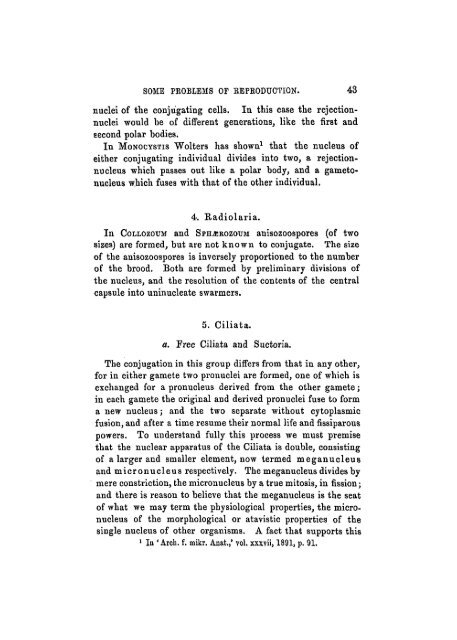Some Problems of Reproduction: a Comparative Study of ...
Some Problems of Reproduction: a Comparative Study of ...
Some Problems of Reproduction: a Comparative Study of ...
You also want an ePaper? Increase the reach of your titles
YUMPU automatically turns print PDFs into web optimized ePapers that Google loves.
SOME PROBLEMS OF BE PRODUCTION. 43<br />
nuclei <strong>of</strong> the conjugating cells. In this case the rejectionnuclei<br />
would be <strong>of</strong> different generations, like the first and<br />
second polar bodies.<br />
In MONOCYSTIS Wolters has shown 1 that the nucleus <strong>of</strong><br />
either conjugating individual divides into two, a rejectionnucleus<br />
which passes out like a polar body, and a gametonucleus<br />
which fuses with that <strong>of</strong> the other individual.<br />
4. Radiolaria.<br />
In COLLOZOUM and SPHJEROZOTJM anisozoospores (<strong>of</strong> two<br />
sizes) are formed, but are not known to conjugate. The size<br />
<strong>of</strong> the anisozoospores is inversely proportioned to the number<br />
<strong>of</strong> the brood. Both are formed by preliminary divisions <strong>of</strong><br />
the nucleus, and the resolution <strong>of</strong> the contents <strong>of</strong> the central<br />
capsule into uninucleate swarmers.<br />
5. Ciliata.<br />
a. Free Ciliata and Suctoria.<br />
The conjugation in this group differs from that in any other,<br />
for in either gamete two pronuclei are formed, one <strong>of</strong> which is<br />
exchanged for a pronucleus derived from the other gamete;<br />
in each gamete the original and derived pronuclei fuse to form<br />
a new nucleus; and the two separate without cytoplasmic<br />
fusion, and after a time resume their normal life and fissiparous<br />
powers. To understand fully this process we must premise<br />
that the nuclear apparatus <strong>of</strong> the Ciliata is double, consisting<br />
<strong>of</strong> a larger and smaller element, now termed meganucleus<br />
and micr onucleus respectively. The meganucleus divides by<br />
mere constriction, the micronucleus by a true mitosis, in fission;<br />
and there is reason to believe that the meganucleus is the seat<br />
<strong>of</strong> what we may term the physiological properties, the micronucleus<br />
<strong>of</strong> the morphological or atavistic properties <strong>of</strong> the<br />
single nucleus <strong>of</strong> other organisms. A fact that supports this<br />
1 In 'Arch. f. mikr. Anat.,' vol. xxxvii, 1891, p. 91.

















